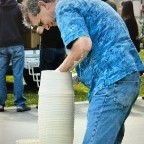
My wife and I finally took a long-awaited vacation to Hawaii. We returned to the same location we had visited previously on the island of Kauai as it was really our kind of place. My wife mainly likes to lay in the sun and read. I like metal detecting the beaches and surf. So it works out well... she parks herself on the beach and I wander around nearby with my detector.
My last trip to Hawaii three years ago produced only one gold ring in two weeks. See the story here for details on that trip. I was determined to do better this time.
I took two detectors, my Garrett Infinium LS, and a new Minelab Excalibur 1000. I have a Fisher CZ-20 that I have been very fond of for freshwater hunting, but many have advised me they thought the Excalibur might do better in saltwater than the CZ-20, although the two machines are very close in performance. My main goal was to use the Infinium, but I wanted a back up unit. In particular, I had discovered some beaches off Kauai have lots of iron trash due to the two hurricanes that hit the island in the last twenty years. PI detectors like the Infinium tend to find iron items while VLF detectors are good at tuning it out, and the Excalibur is particularly good in this regard.
I was most anxious to use the Infinium after my success with it nugget hunting in Alaska, but the first time in the water with the Infinium it binged and bonged and made all sorts of noise. I thought, "This is a heck of a note" and went and got the Excalibur. I had no patience at that point; I wanted to find stuff now. I found lots of coins with the Excalibur and finally a gold ring. The Excalibur was very quiet and handled the salt water environment about as well as I think a VLF detector can. But the fact is that a salt water/volcanic soil environment like Hawaii severely impacts the performance of VLF units, and so the depth of detection I was seeing with the Excalibur was not what I would be expecting with a PI detector.
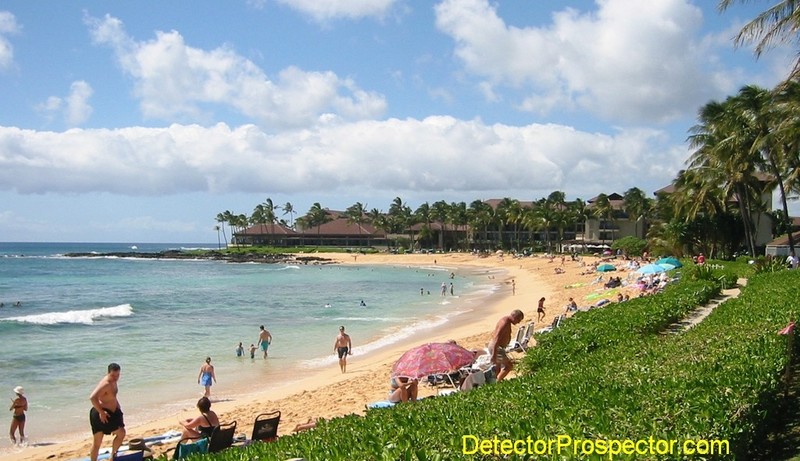
Detecting heaven - Poipu Beach, Kauai, Hawaii
I gave the Infinium a try on the beach to see what the story was there. I found I was getting noise off the salt sand at the end of my swings, and remembered the note in the owner’s manual about this very thing. It is instructed that the discriminate control be advanced to reduce these signals.
I was about to say "false signals" but they are nothing of the sort. The Infinium is a particularly sensitive pulse induction detector. If you tune PI detectors up for their best sensitivity to small gold items you run into the area where saltwater, being a low conductive item, also starts to be detected. The Infinium at its zero discriminate setting picks up wet salt sand and saltwater. It is not a false signal, just a response to a low conductive target a less sensitive unit would not detect at all.
This effect is enhanced by the 14" coil, which "sees" a large volume of material. By advancing the discriminate control to the point at which the salt effect is tuned out you will get stable operation. In theory this also means that some depth of detection or target strength will be lost on smaller low conductive targets like gold earrings. One thing I need to do in the future is test the Infinium at various disc levels to ascertain the effect on target responses.
As a practical matter it does not matter. Just as the sensitivity of a hot VLF detector like the Fisher Gold Bug 2 must be backed off to compensate for high mineral ground, so to the disc control on the Infinium must be set to compensate for the conditions encountered. Hot VLF units cannot be used on wet salt sand at all since they see the salt water as a target and no amount of tuning will get a high frequency VLF to work properly on wet salt sand.
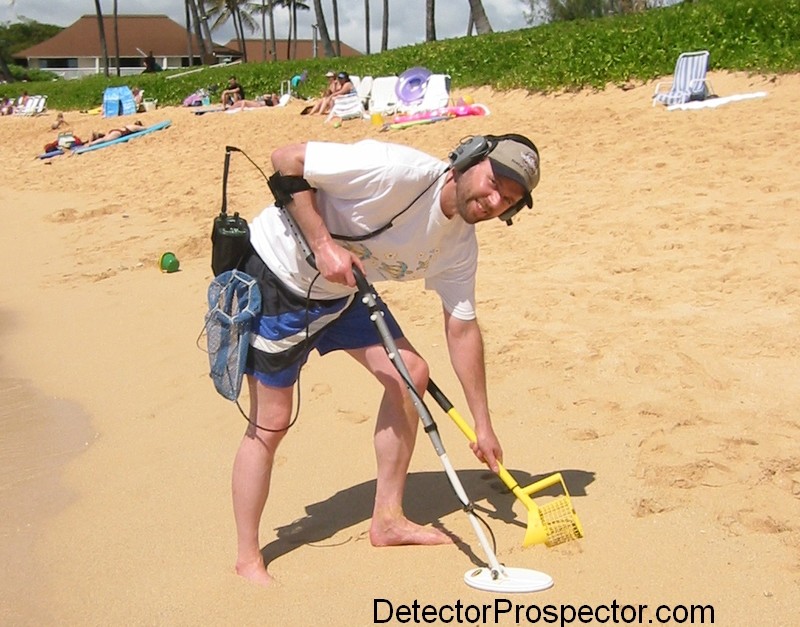
Steve with Garrett Infinium on the beach trying 10" x 5" elliptical DD coil
I did much like I would with the sensitivity control on a VLF detector. I adjusted the disc control to where I was on the edge of stable operation. In other words, I was running with a bit of background noise. Some people might prefer to go farther to eliminate such noises entirely, but I am used to running "on the edge" so to speak. I found the Infinium with 14" coil set at 3-4 disc level gave not quiet but acceptable background sounds on the beach. I proceeded to dig coins and a small toe ring. As I have found in the past the Infinium really likes nickels. I seem to always find a higher percentage of nickels than I would normally find with a VLF detector when I use the Infinium. This is because it is optimized for targets that fall in the nickel range, like most gold items.
Armed with my newfound knowledge I gave the Infinium another try in the surf. And I do mean surf. I had on 40 pounds of weights to help me stay put as the waves crashed into and over me. When I get a target the weights allow me to duck to the bottom and stay put while excavating the target. I use the “fanning” method of blowing sand away with my hand. I’ve tried scoops for this but frankly I’ve got my hands full just hanging on to the detector while working. In high-energy surf the scoops just seem to get in my way.
One thing I have heard speculation on is that the 14” coil might be a problem in the water due to its size. That did not prove to be the case for me. The Infinium is weightless underwater and the feel was good. I had no problem using it in very rough surf and in fact often was forced to brace myself on the bottom with the detector. We are talking adverse conditions at their worst, and the Infinium did fine.
I found a disc setting of 5-6 was required underwater, and even then the coil needed to be kept parallel to the bottom. When I ducked to the bottom to get a target, the coil would turn up and point off into the water. It could then “see” more salt water, and start to signal. But I was so busy holding on and digging targets I really did not notice this much after a while.
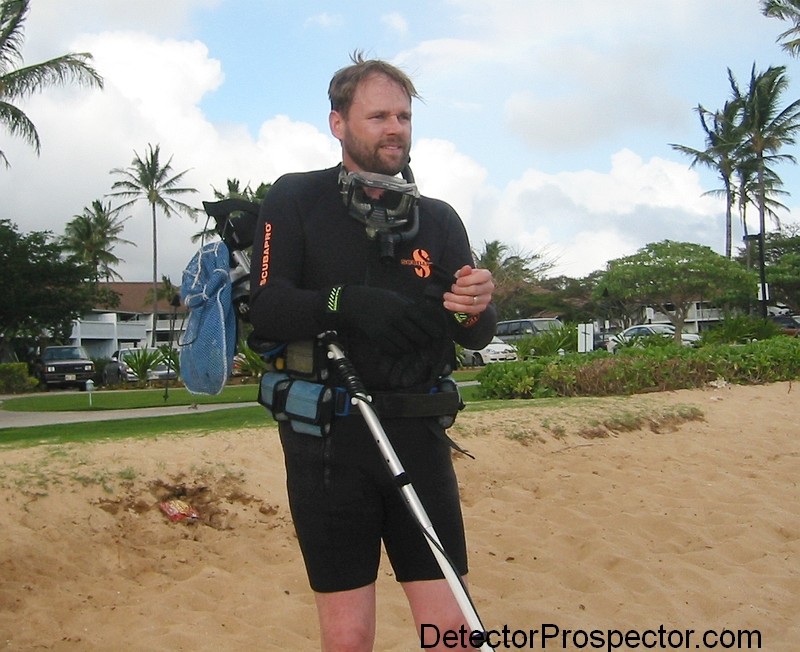
Steve suited up for metal detecting in heavy surf
But lo and behold, the deep targets started coming… and the rings! First real surf dive of about three hours with the Infinium produced three beauties. An 18K gold and platinum ring was first, followed shortly by a 14K gold ring. Then a lull while I dug a few coins and nails (the Infinium does pick up large elongated iron objects the Excalibur ignores) and then a GREAT BIG GOLD RING! I was over a foot down, and expecting a big chunk of trash, when up pops a large class ring - 1963 U.S. Air Force Academy. It is a 14K gold ring with a large synthetic blue star sapphire. It looked incredibly large underwater, and is the most massive ring I have found to date. I'm working on finding the owner of this one.
I was really stoked, but this was Sunday morning, the day before I was to leave. Some beach work with the Infinium and water work with the Excalibur had up until this point produced about 100 coins and one gold ring. But now that I had the Infinium figured out I had three great rings in less than three hours!
The surf really beats me up, so I took a break and spent time with my wife. But that afternoon I hit the water again, and up comes an 18K gold ring with a deep blue faceted sapphire and a platinum band. The depths were all in excess of what I feel I was attaining with the Excalibur. I do not want to give the impression I’m knocking the Excalibur. It is a well proven and well thought of detector, and may in fact have the best performance in salt water of any VLF on the market today. But I just do not think a VLF detector with a 10” coil has much chance versus a PI detector with a 14” coil in saltwater environments.
We had to check out at noon the next day, but I got up early and gave it one last go. A few more nails, some coins, and on last extra wide 14K gold band. I was ecstatic… it just seemed like I could not miss with the Infinium. In two days I found more nice rings than I've found in any other water detecting I've undertaken. My only regret is I did not try harder with the Infinium right off the bat.
I found the Infinium to be a very good saltwater unit, but not having run any pulse units other than the White’s Surfmaster PI in salt water I certainly cannot say how it compares to other PI water detectors. Even the Surf PI I used three years ago has been upgraded to the Surf PI Pro model for enhanced sensitivity to gold items. That fits with what I experienced with the original Surf PI. It got the coins but left me with little gold to show. I would like to try the PI Pro as it is lighter and more streamlined than the Infinium. At $699 list it is also quite the bargain for someone wanting to try a PI detector for water detecting. But the Surf PI Pro also lacks the ground balancing capability and interchangeable coils that make the Infinium so versatile.
The key for anyone using the Infinium around salt water will be to get the disc control set properly. I cannot overemphasize this point. It is the single most important adjustment for making the Infinium work in salt water, and my initial lack of knowledge in that regard cost me precious hunting time. I really think the Infinium disc control can be more properly thought of as a sensitivity control, and the key is to back the sensitivity down to a level that gives stable operation. Do not be concerned about lost sensitivity. I think I proved the machine retains plenty of power. But if you are picking up the saltwater itself you certainly will have little luck in detecting anything else. Still, I should add a cautionary note here. The Infinium WAS noisy! That means different things to different people. For me, as a long-time detectorist, it is just a thing to be dealt with, and I am used to running detectors "on edge". In other words, I often tune detectors to their limits, which many times results in noisy and erratic performance. The difference is that I can tell the difference between "good sounds" and "bad sounds". But someone else listening to what I am doing might not hear the difference, just lots of noise.
So lest this story sound like a glowing reason to run out and get an Infinium do take note of its noisy performance here. I obviously made it work for me, but some people may not like either the noise, or the amount of discrimination required to reduce the noise to normal levels. For dry land use, especially while nugget detecting, I feel the Infinium is a very good detector. In salt water the results are mixed, and will depend a great deal more on the expertise of the detectorist. The White's Surf PI was a much smoother and easier to operate detector by comparison, and may suit the casual operator more than the Infinium if salt water is the sole intended use.
The Excalibur is the only VLF detector I have ever used in salt water. It was much quieter in operation than the Infinium, although it constantly gave multiple tones on each target instead of locking on a single tone. It did a superb job of ignoring iron targets, and if there were enough iron targets it would certainly be the way to go. But the amount of iron I dug with the Infinium was nowhere near the level it would take to discourage me, and the bit of extra depth I feel I was getting with a PI made me feel more than happy to dig the few iron targets. The ratio was no worse than one iron target for every two or three non-iron targets. I think that unless iron trash is a problem PI is the way to go. I'm surprised that Minelab, manufacturer of what many believe are the most powerful PI units in the world, does not build an underwater PI unit. On the other hand, I have some fresh water lakes I hunt in Alaska that are full of iron trash, and I am anxious to use the Excalibur in those lakes.
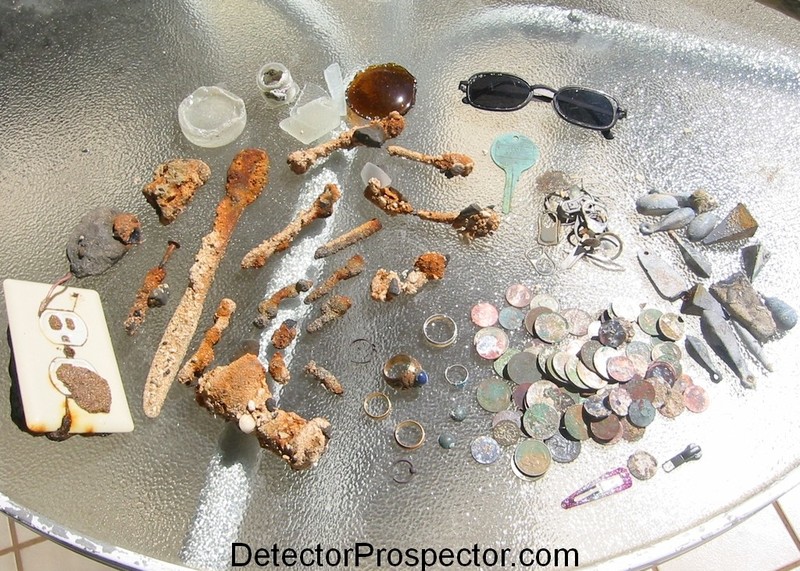
Iron junk, rings, coins, aluminum trash, and lead weights found metal detecting
The picture above shows a typical mix of finds, although some of the oversized trash items have already been discarded. The first place I usually head after getting out of the water is the nearest trash can. In fact, I try to make a spectacle of myself disposing of the trash, especially the sharp glass I retrieve. It helps promote the image of detectorists as public servants. Hey, we are just getting this dangerous junk out of here.
The iron items were all found with the Infinium. The Excalibur ignores iron better than any detector I have used. The majority of the coins were found with the Excalibur, although the Infinium got its share, especially nickels. Almost all the pull tabs were found with the Infinium, again confirming its power in the gold range. Many rings are identified by metal detectors as pull tabs because of their similarity electronically, and so the Infinium likes them also. Notice also the large fishing sinkers found by both detectors. I gave these to the dive shop I rented my dive gear from.
If you are planning on doing some surf detecting in Hawaii, here is how I outfit myself. Obviously you need some kind of underwater detector. I prefer two, as I have had two different underwater detectors leak on me over the years. The chances are slim, but vacations like this are few and far between. It's cheap insurance. I use a neoprene shorty suit while in the water. The water in Hawaii is warm, but it can get chilly if you are fully submerged for some time. I also find the suit helps cushion the weight belts to prevent chafing. I used two weight belts totaling about 40 pounds. The weight belts and suit were rented locally. Each item was $18 for the week, for a total rental of $54.00. Next time I plan to have a suit with long legs to protect my knees while down on the bottom.
I wore an old pair of tennis shoes and socks while in the water. There are lots of rocks and coral that can chew your feet up, not to mention spiny animals like sea urchins. This seemed to work very well and I would do the same thing again. I have a mesh bag that I attach to the arm of the detector for targets I retrieve that also has worked very well. It has a hooped metal opening that makes it easy to drop items in the bag, and yet I have never had a problem with anything getting out of the bag. I have a mask and snorkel that I have used for dredging and diving for many years that continues to give good service. The snorkel is a U.S. Divers model that features a water catch and drain system near the top that sheds water caught by waves going over the top. A good idea for surf work. Finally, a good pair of neoprene gloves to protect my hands while digging holes or holding on to coral.
The only item I wished I had was a small rock pick. Every once in awhile I would find items that worked down into deep holes in the dead coral bottom. I had to abandon some of these as the items were too far down in the small cavities. A small rock pick would have allowed me to open the holes up to find those items... whatever they were.
Time for a safety warning. Surf conditions can be dangerous and working over weighted can be particularly hazardous. It is important to be completely comfortable in the water and to have a realistic knowledge of your limitations. I have made hundreds of SCUBA dives and have thousands of hours on hookah diving systems. I am extremely comfortable in the water and there is little that could happen that would cause me to panic. Do not attempt rough surf conditions without being sure of yourself and your equipment.
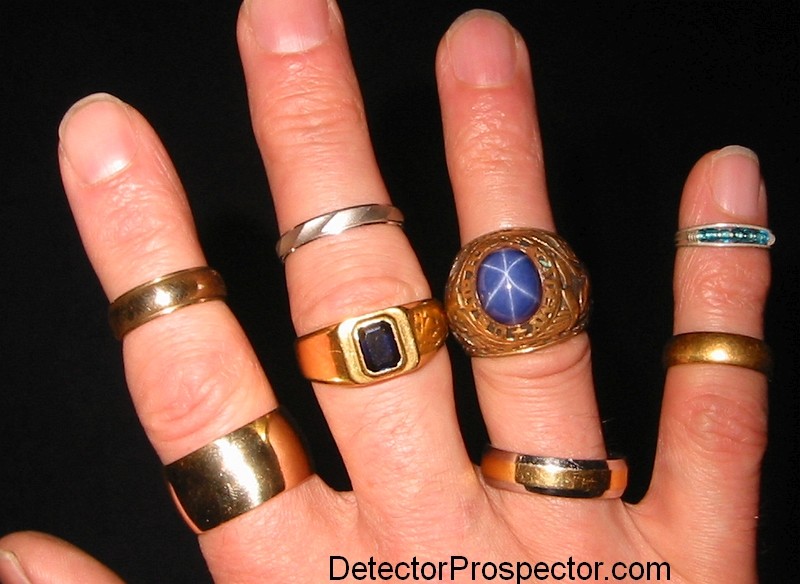
All found with Garrett Infinium except small gold ring on pinky finger
Index Finger - Two 14K gold bands
Middle Finger - Platinum band and 18K gold w/faceted sapphire
Ring Finger - 14K Class Ring w/synthetic star sapphire and 18K gold & platinum band
Pinky Finger - Stainless steel toe ring and 22K gold band (Excalibur)
As far as where to hunt? Well, on the beach itself there is a zone up above where everyone sits. Lots of coins there. But if jewelry is the goal you need to get into the body-surf/boogie board zone. And that is pretty much where the waves are breaking. A rock or coral base with no more than about a foot of sand on it would be preferred. You do want some sand to hide items when dropped, but too much and items sink beyond detector range. The sand gets stirred a lot in this zone, and so stuff gets deep pretty fast. Areas where lots of tourists are in the water will generally be more productive than areas the locals frequent. It's a more affluent crowd and one that is more ignorant of the effects of water on jewelry. Just make sure you take time to watch people a lot. Just sit on the beach and watch people at play and where they are doing it. Any of those areas have potential, and the more vigorous the play, the better the potential.
It was a great trip, albeit too short. I’m chomping at the bit for another go. I have often gone on nugget hunting trips where it seems like I spend 3/4 of my time getting my bearings, and then really start to score just before I run out of time. This was one of those trips, and between my trip three years ago and this one I think I’m getting a handle on surf detecting now. I can guarantee it won’t be three years before I next hit the surf in search of gold.
~ Steve Herschbach
Copyright 2003 Herschbach Enterprises
Postscript 3/25/03 - A happy ending to the 1963 U.S. Air Force Academy Class Ring story. The class is celebrating their 40th reunion in 2003, and by contacting the reunion organizer I was able to find the owner of the ring. He lost it 17 years ago while body surfing in Hawaii and sure was surprised to hear his ring had been found. I hope he gets it refinished and wears it to that 40th reunion!
-
 5
5





